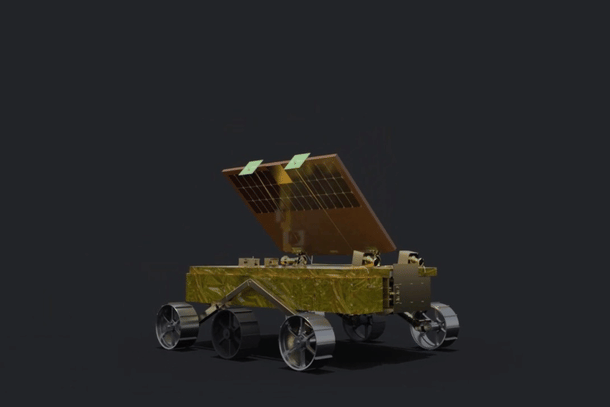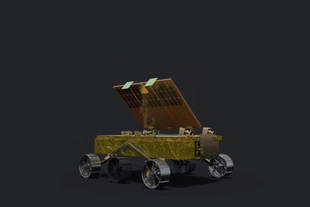Science
Pragyan Rover On Chandrayaan-3: All You Need To Know
Karan Kamble
Aug 23, 2023, 08:03 PM | Updated Aug 24, 2023, 10:46 AM IST
Save & read from anywhere!
Bookmark stories for easy access on any device or the Swarajya app.


Rovers are cool, aren’t they?
These little mobile explorers undergo the harsh conditions of an entirely foreign world hoping for a short staycation of a lifetime — if they are able to arrive at their destination, that is.
India, too, has a rover which will soon be moving about on the surface of the Moon, after India became the first country ever to land in the south pole region and only the fourth ever to soft-land on the lunar surface.
India will join the Soviet Union, the United States (US), and China to deploy a rover on the Moon and then have it “rove,” or move about, on the lunar surface — one of the mission objectives for Chandrayaan-3.
In doing so, the rover will also leave an imprint of the Indian state emblem, an adaptation of the Lion Capital of Asoka at Sarnath, and ISRO logo on to the Moon's surface.
In the previous Chandrayaan mission, India’s lunar rover didn’t even get the chance to do its work. The lander, in whose belly the rover was placed, had crash-landed on the Moon.
What's a rover?
A rover is simply a vehicle for exploring the surface of a planet or moon.
A popular rover name that pops up often these days is Perseverance. Of course, one may recall many other popular rovers of the past — Curiosity, Opportunity, and Spirit, among others.
Perseverance, the most recent one, was launched in July 2020 by the National Aeronautics and Space Administration (NASA) as part of its Mars 2020 mission and reached in February 2021.
It has been given the important job of seeking out signs of ancient life and collecting samples of rock and regolith (broken rock and soil) for a possible return to Earth. So far, it’s been up to the task.
Similarly, the Indian Space Research Organisation (ISRO) will deploy its lunar rover, named Pragyan, with a similarly important job as part of the Chandrayaan-3 mission.
The rover's name ‘Pragyan’ is Sanskrit for wisdom.
The six-wheeled, 26 kg rover is seated within the lander module. Its communication with Earth will take place via the lander.
Now that the Vikram lander has successfully soft-landed on the Moon, the rover will get to work possibly in a few hours' time or within a day's time.
Pragyan rover
According to NASA’s description, “The (Pragyan) rover is a rectangular chassis… mounted on a six-wheel rocker-bogie wheel drive assembly. It has navigation cameras and a solar panel that can generate 50 W. It communicates directly with the lander via Rx/Tx antennas.”
Pragyan has been assigned the task of carrying out a chemical analysis of the lunar surface in situ as it moves about in the highlands near the Moon’s south pole.
It is equipped with two payloads for carrying out scientific experiments, namely the Alpha Particle X-ray Spectrometer (APXS) and the Laser Induced Breakdown Spectroscope (LIBS).
Whereas the APXS will try to determine the elemental composition of the lunar soil and rocks around the landing site, the LIBS will be responsible for qualitative and quantitative elemental analysis, deriving the chemical composition, and inferring the mineralogical composition.
The LIBS will come into play through the spectroscopic study of gases emitted from the surface of the Moon after it is melted using lasers.
The work with the APXS, on the other hand, will involve shooting alpha particles on to the lunar surface and creating emissions, and then studying the chemical composition.
The rover will specifically look for the elements magnesium, aluminium, silicon, potassium, calcium, titanium, and iron.
Pragyan will additionally study the Moon’s atmosphere. It is often said that the Moon has no atmosphere, but that isn’t exactly right. There is a little atmosphere near the lunar surface.
“Gases do come out of it (the Moon) and they get ionised and they stay in the very close proximity of the surface. And this changes with the day and night. So we want to study day and night how this small atmosphere, very atomic atmosphere, which is charged particle, are varying,” ISRO Chairman S Somanath told the media on 10 July on the sidelines of India Space Congress 2023.
Pragyan has a mission life of 1 lunar day, approximately equal to 14 Earth days. This will be the period over which the Indian rover will try to fulfill its objectives.
The rover's period of operation has been constrained by its energy source — the Sun. It is all hale and hearty when the Sun is up, as it now is, with the lunar sunrise coinciding with the lander touchdown.
But when the Sun will set on the Moon, the rover will not be able to draw any power, and the electronics will have to endure the frigid night that follows.
However, there may be a small chance that when the Sun next rises on the Moon, the rover gets back to work — this will be a matter to simply wait and watch, and hope.
What rovers came before?
If Pragyan is successful, even partially, it will be in the good company of previous lunar rovers. Surprisingly, there haven’t been many.
The Soviet Union’s Lunokhod 1 opened the chapter on robotic rovers operating on the Moon, or anywhere outside Earth, towards the end of 1970.
The second Soviet lunar rover, Lunokhod 2, was deployed not long after, in January 1973.
In between the two Lunokhods was the US-made lunar roving vehicle (LRV), deployed in the last three Apollo missions (15-17) during 1971-72.
Unlike the regular robotic rovers that came before and after it, the LRV could carry people and things — one or two astronauts, some equipment, and lunar samples.
After the Lunokhod 2, it took over four decades for the next lunar rover to arrive on the scene. Yutu, or Jade Rabbit, was deployed in December 2013 as part of China’s Chang'e 3 space exploration mission.
Six years later, Yutu-2 of the Chang'e 4 mission did better than its predecessor, roving a significantly larger area of the lunar surface. It also became the first rover to operate on the far side of the Moon.
Unfortunately, three rovers since Yutu met with failure on the Moon. They weren’t even able to see the light of day as the landers carrying them tragically crash-landed on the lunar surface. The Pragyan rover of Chandrayaan-2 was among them.
Similarly, the Rashid rover of the United Arab Emirates (UAE) and the Japanese SORA-Q transformable lunar rover couldn’t get to work after the Japanese Hakuto-R lander crashed into the Moon in April 2023.
Even an Israeli lander called Beresheet crashed on the Moon while attempting to land in April 2019, the same year as Chandrayaan-2, but it wasn’t carrying a rover.
Mission Pragyan
Chandrayaan-3’s Pragyan gets another shot now.
A ramp will open out from one side of the Vikram lander, and the rover will roll down and reach the surface.
If the operation is the same as with Chandrayaan-2, Pragyan will use its navigational cameras to scan its surroundings and relay the information back to mission control via the lander.
Instructions on the trajectory will be relayed back to Pragyan and it will set off on its path accordingly.
Meanwhile, the lander will have eyes on the rover at all times using its own cameras.
The Moon’s surface isn’t exactly a skating ring. For that reason, the “rocker-bogie” on the rover will help it move along its trajectory even in rough terrain.
The rocker-bogie mechanism has a 50-millimetre movement range upwards and downwards to absorb the tiny bumps and potholes.
The ISRO mission control will interact with Pragyan if it wants the rover to stop and use its scientific instruments to make a determination of the elemental composition of either the lunar rocks and soil (APXS) or the surface (LIBS).
Wherever Pragyan goes, it will have to stay within 500 metres of the Vikram lander. And it can move at a speed of 1 centimetre per second only.
Lunar south pole
Notably, the rover will be traversing no ordinary location.
The region that Pragyan will explore is the lunar south pole. Previous successful Moon missions landed at lower latitudes.
The south pole region is of particular interest because parts of it are permanently under shadow and, therefore, likely made up of ice and precious minerals.
A close-up view of some of the larger shadowed craters in the area could possibly help scientists improve their understanding of the composition of the early Solar System.
For all the science that’s possible, besides the rise of ISRO as a spacefaring giant, let’s hope Pragyan gets to do what it couldn’t last time around.
Follow Swarajya's Chandrayaan-3 dashboard for mission updates.
Karan Kamble writes on science and technology. He occasionally wears the hat of a video anchor for Swarajya's online video programmes.





